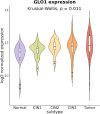Glyoxalase 1: Emerging biomarker and therapeutic target in cervical cancer progression
- PMID: 38870176
- PMCID: PMC11175447
- DOI: 10.1371/journal.pone.0299345
Glyoxalase 1: Emerging biomarker and therapeutic target in cervical cancer progression
Abstract
Introduction: Cervical cancer presents a significant global health challenge, disproportionately impacting underserved populations with limited access to healthcare. Early detection and effective management are vital in addressing this public health concern. This study focuses on Glyoxalase-1 (GLO1), an enzyme crucial for methylglyoxal detoxification, in the context of cervical cancer.
Methods: We assessed GLO1 expression in cervical cancer patient samples using immunohistochemistry. In vitro experiments using HeLa cells were conducted to evaluate the impact of GLO1 inhibition on cell viability and migration. Single-cell RNA sequencing (scRNA-seq) and gene set variation analysis were utilized to investigate the role of GLO1 in the metabolism of cervical cancer. Additionally, public microarray data were analyzed to determine GLO1 expression across various stages of cervical cancer.
Results: Our analysis included 58 cervical cancer patients, and showed that GLO1 is significantly upregulated in cervical cancer tissues compared to normal cervical tissues, independent of pathological findings and disease stage. In vitro experiments indicated that GLO1 inhibition by S-p-bromobenzylglutathione cyclopentyl diester decreased cell viability and migration in cervical cancer cell lines. Analyses of scRNA-seq data and public gene expression datasets corroborated the overexpression of GLO1 and its involvement in cancer metabolism, particularly glycolysis. An examination of expression data from precancerous lesions revealed a progressive increase in GLO1 expression from normal tissue to invasive cervical cancer.
Conclusions: This study highlights the critical role of GLO1 in the progression of cervical cancer, presenting it as a potential biomarker and therapeutic target. These findings contribute valuable insights towards personalized treatment approaches and augment the ongoing efforts to combat cervical cancer. Further research is necessary to comprehensively explore GLO1's potential in clinical applications.
Copyright: © 2024 Kim et al. This is an open access article distributed under the terms of the Creative Commons Attribution License, which permits unrestricted use, distribution, and reproduction in any medium, provided the original author and source are credited.
Conflict of interest statement
No potential conflict of interest relevant to this article was reported.
Figures




Similar articles
-
GLO1 regulates hepatocellular carcinoma proliferation and migration through the cell cycle pathway.BMC Cancer. 2024 Oct 21;24(1):1297. doi: 10.1186/s12885-024-12927-x. BMC Cancer. 2024. PMID: 39434012 Free PMC article.
-
Selective activation of apoptosis program by S-p-bromobenzylglutathione cyclopentyl diester in glyoxalase I-overexpressing human lung cancer cells.Clin Cancer Res. 2001 Aug;7(8):2513-8. Clin Cancer Res. 2001. PMID: 11489834
-
Emerging Glycation-Based Therapeutics-Glyoxalase 1 Inducers and Glyoxalase 1 Inhibitors.Int J Mol Sci. 2022 Feb 23;23(5):2453. doi: 10.3390/ijms23052453. Int J Mol Sci. 2022. PMID: 35269594 Free PMC article. Review.
-
Glo1 genetic amplification as a potential therapeutic target in hepatocellular carcinoma.Int J Clin Exp Pathol. 2014 Apr 15;7(5):2079-90. eCollection 2014. Int J Clin Exp Pathol. 2014. PMID: 24966916 Free PMC article.
-
Glyoxalase I in tumor cell proliferation and survival and as a potential target for anticancer therapy.Oncol Res Treat. 2014;37(10):570-4. doi: 10.1159/000367800. Epub 2014 Sep 11. Oncol Res Treat. 2014. PMID: 25342507 Review.
Cited by
-
Immunological features of various molecular subtypes of cervical cancer and their prognostic implications in the context of disulfidptosis.Front Oncol. 2025 May 14;15:1574911. doi: 10.3389/fonc.2025.1574911. eCollection 2025. Front Oncol. 2025. PMID: 40438679 Free PMC article.
References
-
- Jandial R, Neman J, Lim PP, Tamae D, Kowolik CM, Wuenschell GE, et al.. Inhibition of GLO1 in Glioblastoma Multiforme Increases DNA-AGEs, Stimulates RAGE Expression, and Inhibits Brain Tumor Growth in Orthotopic Mouse Models. Int J Mol Sci. 2018;19(2). Epub 2018/02/02. doi: 10.3390/ijms19020406 ; PubMed Central PMCID: PMC5855628. - DOI - PMC - PubMed
MeSH terms
Substances
LinkOut - more resources
Full Text Sources
Medical
Molecular Biology Databases
Research Materials
Miscellaneous

